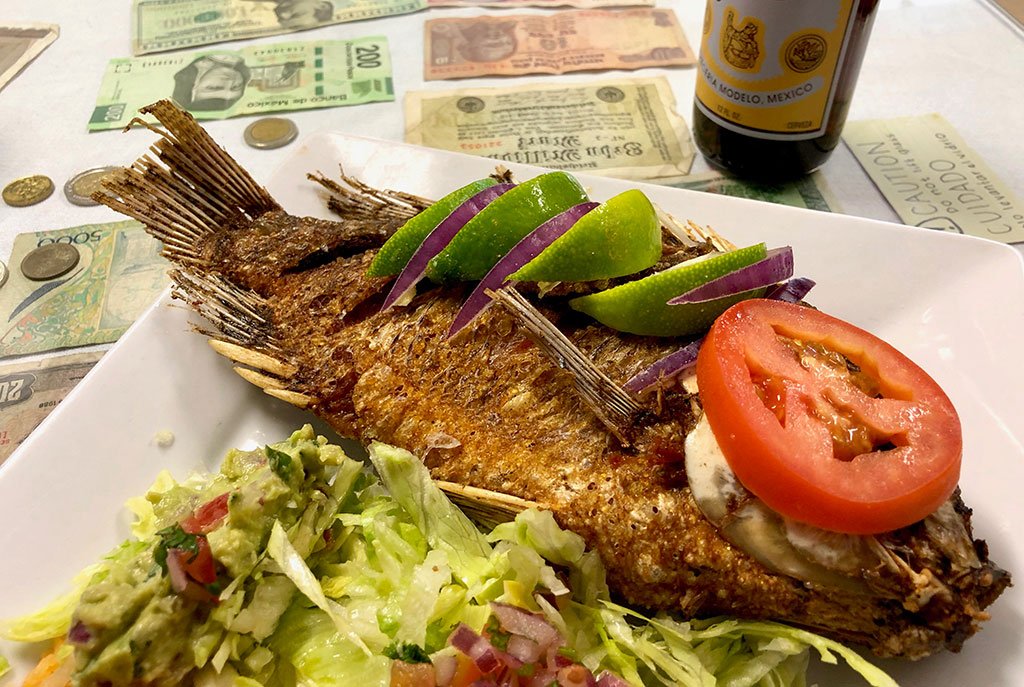Local Whole-Fish Dishes Cater to Family-Style Diners and Adventurous Gourmands Alike

by Nick Williams at Indy Week
Image: Mojarra at El Restaurante Ixtapaby (Nick Williams)
With a subtle flourish from the server, the mojarra arrives, a black sea bass fried to a bristling shatter, coyly dressed in lime slices and red onion. At first, it’s unclear exactly how to crack its seasoned carapace, but there’s no choice but to dive in, forks scraping and fingers prying every morsel from its armature of bones. Is that a fin? Eat it in one bite, tiny bones dissolving in sweet fish juice. At El Restaurante Ixtapa, a tiny Mexican joint tucked away next to the Eno River in Hillsborough, mojarra is one of dozens of whole-fish dishes—head and tail often intact—being served at restaurants across the Triangle in an affirmation of the joys of bones-and-all seafood.
Depending on the setting, eating whole fish can be a lavish and rococo act of precision gourmandize. It can be celebratory, an embodiment of the primal spectacle of an entire animal lovingly prepared and displayed for consumption. But eating a whole animal can also come with a pleasant, even quotidian sense of abandon, the same urge for indulgence often satisfied by a shrimp boil or pig pickin’. It’s a messy, hands-on enterprise, and the skeletonized remains can present pleasantly gory evidence of a job well done. And while they can certainly be a feast for one, whole fish are an exemplar of the current rage for eating family-style, often serving as the centerpiece around which gather a caucus of shareable plates.
“It represents abundance … and completion,” says David Yu, owner of Carrboro’s Gourmet Kingdom, explaining why whole fish is ubiquitous on tables across China during Chinese New Year. “In Mandarin, the word for ‘fish’ and the word for ‘abundance’ have the same pronunciation.”
Gourmet Kingdom usually has about ten whole-fish dishes on the menu, most of them tilapia. Yu, after thoughtfully checking on my spice tolerance, unabashedly recommends the crispy whole fish in Szechuan bean sauce. Draped in a fiery cloak of chili and fermented black bean, it’s an exercise in maximalism, especially compared to Ixtapa’s relatively unadorned version.
A whole fish hitting the table is an event in any setting, but it’s particularly showstopping at Gocciolina, Aaron Benjamin’s beloved Italian restaurant in Durham. In fact, Gocciolina’s whole grilled fish, in its mesmerizing broth of lime and Calabrian chili, served as initial inspiration for this story. It’s a perfect dish for collaboration. Excising every morsel from the skeleton becomes a party game in which the currents of food karma dictate that one shares the best bits—the belly, the cheek, the muscle behind the eye—with grateful tablemates.
Until recently, Gocciolina used branzino for its whole fish. Branzino is sustainably farmed in the Northern Atlantic and is prized in East Coast restaurants for its meaty flavor and satisfying texture. But Benjamin has begun using wild-caught fish like vermillion snapper for his whole grilled fish, and he expanded the restaurant’s selection to include occasional preparations of sea mullet, spot, and perch.
Whole-fish dishes, while visually striking and labor-intensive to eat, don’t always have to be special-occasion food. North Carolina’s rich culinary history is a litany of whole-fish preparations, most of them aimed squarely at the humble family table. No local chef advocates for the everyday pleasures of whole fish like Ricky Moore, coastal North Carolina native and owner of Durham’s Saltbox Seafood Joint. Moore, however, prefers the more descriptive term “bone fish.”
Fried croaker plate at Saltbox Seafood Joint
“I’m a bone-fish evangelist,” says Moore. “For people who don’t usually eat fish with the bone in it, ‘whole’ is more palatable. And customers have been conditioned to receive that—they’re not used to seeing croaker on the menu.”
Croaker—a hearty little fellow maxing out at about one-and-a-half pounds—is one of many abundant species that congregate in coastal waters. Moore wants to see more of these small, relatively common fish on menus, and not just because they taste great when fried up whole.
Mild-tasting, white-fleshed fish like snapper and flounder are extremely popular and often delicious, but overfishing has led to reduced seasonal stocks and strict catch-limits. This results in expensive and environmentally unsustainable fish, not a great pick for the unfussy meals Moore serves in his restaurants.
“The sustainable fish you can eat right now—croaker, spot, pigfish, butterfish, sea mullet, et cetera—these are best served as whole, bone-in fish,” Moore says.
A few bites of Saltbox’s bone-in croaker are delectably convincing. They come three to an order, enough to share or to sate a solitary craving. The preparation is similar to Ixtapa’s, but the seasoning—subtly piquant and complex—is evocatively Southern, serving only to enhance the natural flavor of the flesh. It tastes like the fish jumped into the net pre-seasoned, happily ready for the fryer.
And yes, it comes with a hell of a lot of bones. Fortunately, many of them are edible.
“The joy in eating whole bone-in fish as I grew up eating it, you got to cook it to a level that I call ‘fried hard,’” Moore says. “Extra crispy, crunchy. You wouldn’t cook a snapper to that degree of doneness.”
Moore briefly ponders a public tutorial on how to best enjoy these little suckers. “The idea is, when you fry it hard, all those bones that may be a bit cumbersome, you can eat ’em! Eat the fin, eat the tail. Almost like a fish cracker.”





